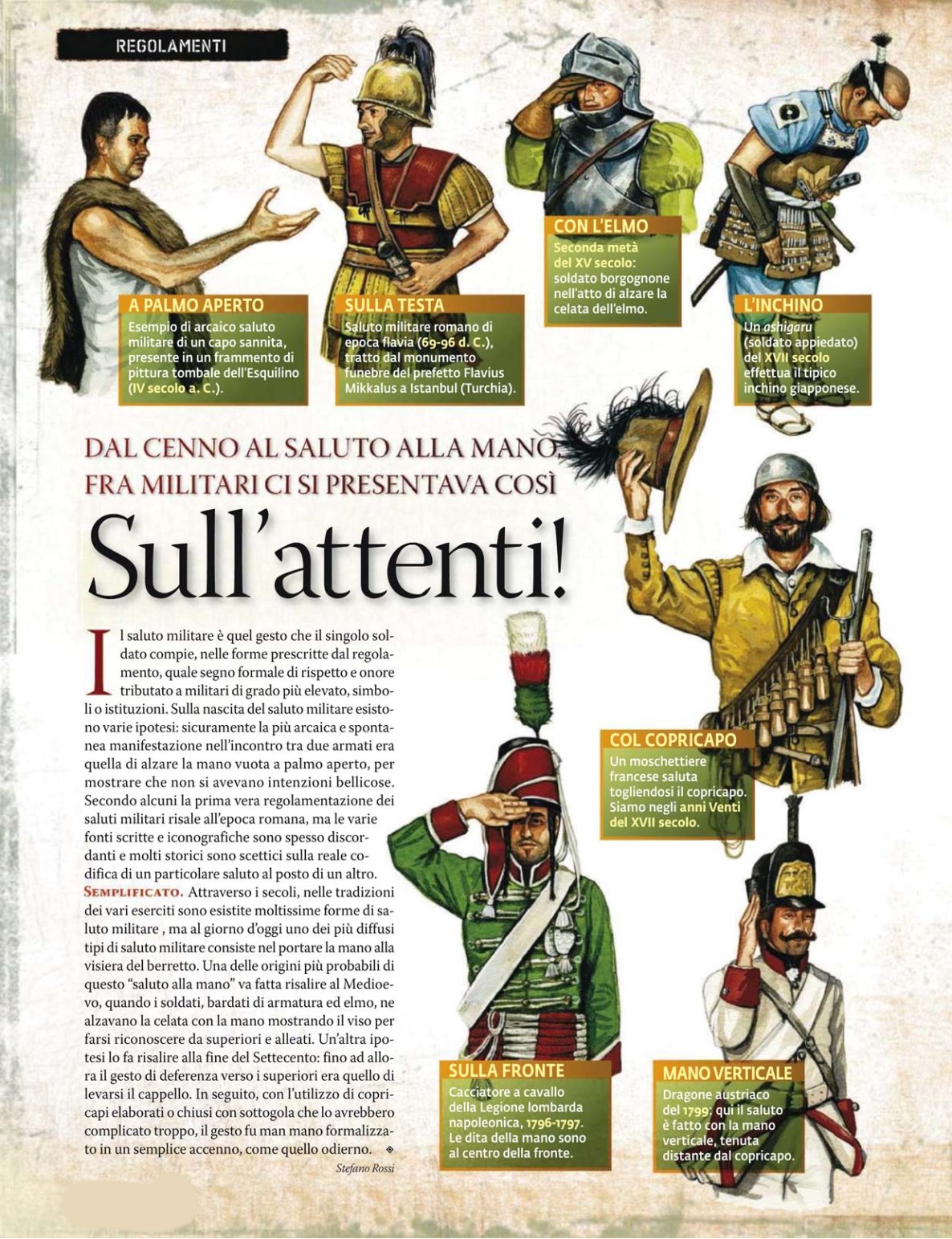
Perhaps the oldest and most ubiquitous military custom is that of the salute. Although most commonly given by hand, a salute can also be rendered by guns, swords, banners, or music. Many writers have suggested that the hand salute dates back to the time when man still lived in caves. When encountering a stranger, one could never be sure whether the approaching individual was friend or foe. A raised right arm, hand empty and extended, was a reliable indication of non-hostile intent.
The raised right arm salute was universally practiced by the Romans. Indeed, the English word salute is derived from the Latin word salutare, meaning “to greet. ” Before engaging in mortal combat in the arena. Roman gladiators would form before Caesar, and with upraised arm cry out: “Ave Caesare. Morituri te salutamus “We who are about to die greet you”). Other writers believe that the practice of raising the hand to the peak of the headdress originated in the age of chivalry. The theory goes that when armored knights met, they would raise the visors of their helmets both to enable mutual recognition and to convey the message that there was no hostile intent. On the other hand, given the inordinately heavy, uncomfortable, and clumsy full armor of the era. it is unlikely that knights would routinely ride about so attired (much less with the vision-restricting visor in placed unless prepared to engage in immediate battle.
Today, the salute is practiced by virtually all organized military forces. Customarily, the salute is not only rendered among members of the same nation’s forces but also between members of friendly foreign nations-that is, countries with which we are not at war. There are, however, historical examples of prisoners of war saluting the officers of the capturing armies, for whom they had great respect (such was the case with Field Marshal Erwin Rommel). In effect, the salute has become a comradely greeting between fighting men who share common values, dangers, and ethics.
A fact sometimes overlooked is that it is not absolutely
necessary that the salute be initiated by the junior, although many a junior
officer has received a dressing-down for not recognizing that retired officers
are still officers and entitled to all the courtesies of rank-including a
salute. In the American armed forces, it is not improper for the senior to
initiate the greeting. Even the most senior American officers will initiate a
salute to a soldier of any rank wearing the Medal of Honor.
When a group of soldiers is engaged in outdoor work, the
senior person in charge salutes for the detail while the others continue
working. The same procedure is followed at athletic events. The participants
continue the sport, the one in charge salutes.
Depending on national custom, a soldier earning a rifle
salutes by bringing either hand to some point of the rifle, depending on how
the weapon is being held at the time. Since the rifle will normally be in the
right hand, the salute is rendered with the left.
A salute can also be fired. Friendly foreign naval vessels are sometimes saluted with blank cannon fire, and heads of state and other dignitaries of friendly nations are also often greeted in this manner upon arrival. The custom supposedly started when ships and/or shore batteries would harmlessly discharge their cannon to show that they were now unloaded and there was no hostile intention. Usually, the maximum number of rounds is 21, although any number of guns may participate in a salute battery.
A final rifle salute is commonly fired over the grave of a
fallen warrior. This appears to be not so much a tribute as the carrying on of
the old superstition of frightening evil spirits away from the grave.
Customarily, three volleys are fired by an honor guard.
While the wearing of swords has been relegated to ceremonial
roles-usually by officers-in modern times, a salute is rendered with swords
when they are carried unsheathed. In a parade, unit banners, guidons, and unit
flags are customarily “dipped” before reviewing dignitaries and
officials. The national colors or standards of the United States, however, are
never lowered or dropped, although this custom is not universal in all armies.
Salutes may also be rendered musically, not only by full bands but also by
bugles, drum rolls, bagpipes, or other suitable instruments. All have the
effect of calling attention to the importance of the occasion or the personage
being honored. Some of these ceremonies can be extremely elaborate and instill
great pride.